Posted by Nodus Labs | June 18, 2023
AI Tools for Writing
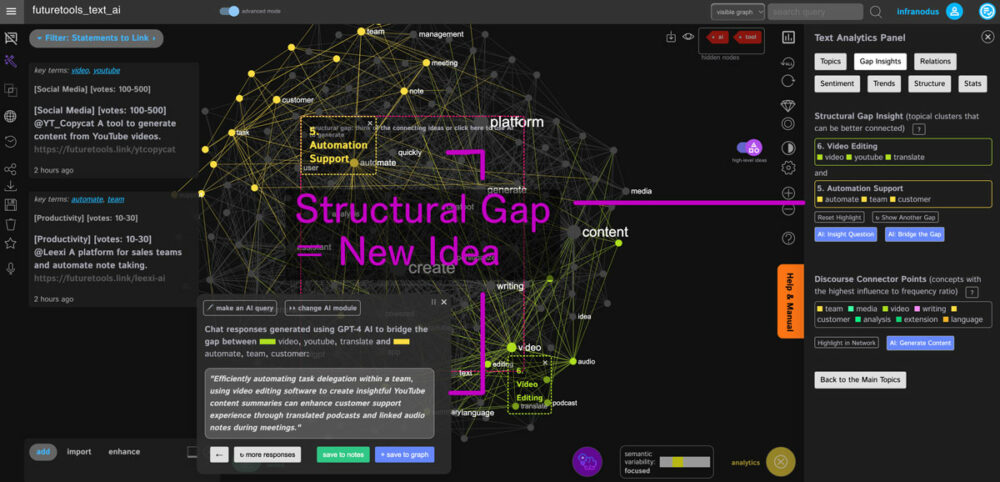
There are hundreds of AI tools for writing and they offer a wide range of functionalities. In order to better understand the landscape of artificial intelligence apps for text available today, we decided to analyze them using InfraNodus.
Our interest was to find what those tools offer and what are the most popular ones. Using InfraNodus, we can also detect the structural gaps in the current market: concepts that could be better connected or are missing. These gaps, or the blind spots, can reveal potentially promising ideas to develop in the nascent AI market. Combined with keyword research, we can then overlay our insights about supply (based on the tools’ descriptions) over our insights about demand (content that people search for) and discover the most promising niches in terms of the customers’ interest.
Getting the Data: the Current Supply in the AI Market
In order to get this data, we used one of the most popular online directories for AI tools — FutureTools.io. We loaded a list of tools and their descriptions for the categories that relate to text: AI detection, For Fun, Productivity, Inspiration, Marketing, Research, Translation, Chat, Generative Code, Self-improvement, Copywriting, Social media, Finance, and Podcasting. We obtained a total of 1311 records this way.
We then took the descriptions of the tools (provided by users or their authors) and visualized them as a text network graph in InfraNodus. This network graph represents the words as the nodes and their co-occurrences as relations. This is how most NLP models actually see any text.
We then hide the words “ai” and “tools”, because they are present in almost all the descriptions to see the context around them. Based on this representation, we can then identify the main thematic clusters and high-level ideas using a combination of NLP, text network analysis, and AI tools built-in InfraNodus:
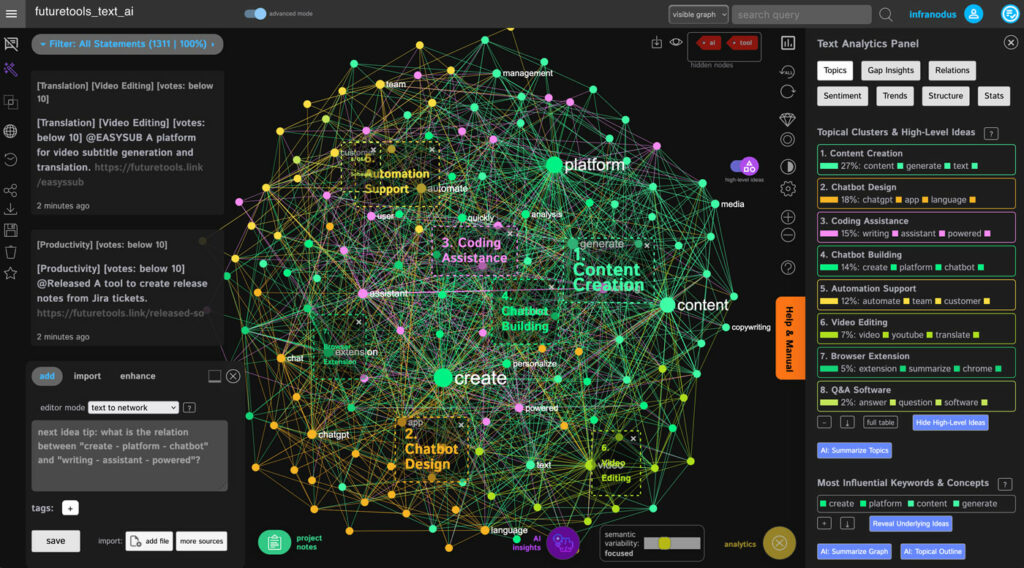
To navigate in this graph, open the link below in a new tab and choose the keywords that seem interesting to filter the tools that contain these terms:
www.infranodus.com/infranodus/futuretools_text_ai
AI Business Ideas: Structural Gaps between AI Niches
We can use InfraNodus graph to detect a structural gap between the niches and see if there are interesting tools that we imagine that would combine the topical clusters that are not yet connected. On top of that, we can use the built-in AI to generate this business idea for us.
In order to do that, we reset all the filters to see the descriptions for all the AI tools. Then we click on Analytics > Gap Insight and choose two distinct topical clusters that exist in the discourse but are not well connected. For instance:
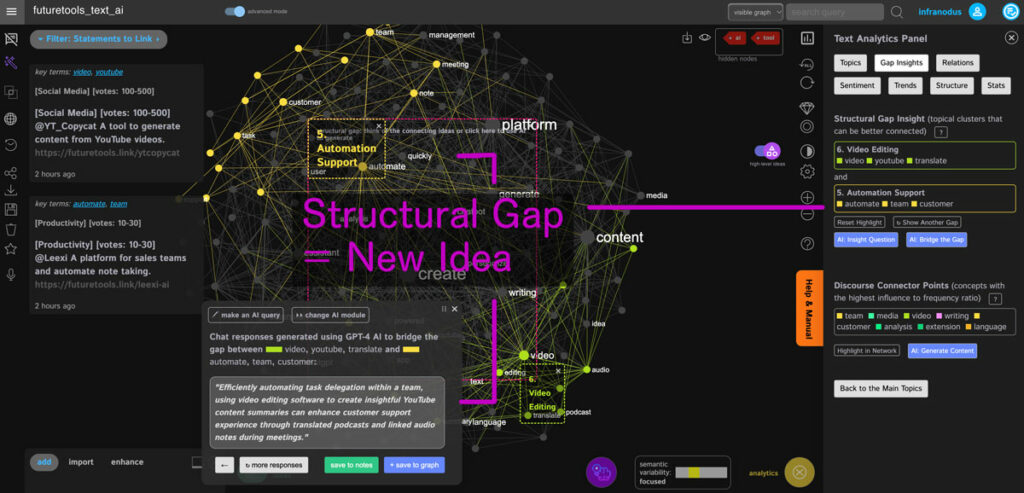
In our case, we can see that there is a cluster of tools for youtube video summarization and another cluster of tools for team meeting automation.
We can then use the built-in GPT-4 AI in InfraNodus to generate an idea that would link these two clusters together:
“Efficiently automating task delegation within a team, using video editing software to create insightful YouTube content summaries can enhance customer support experience through translated podcasts and linked audio notes during meetings.”
In this example, GPT-4 proposes we think of an AI tool that could provide content summaries for various materials used in a meeting.
An even more interesting result is produced when we generate a research question:
How can automation tools be used to enhance the productivity of YouTube content creators, while improving their customer support and meeting note-taking capabilities?
For instance, we could think of an AI tool that could be marketed to YouTube content creators helping them interact with and better understand their audience through analyzing YouTube video comments or writing scripts for their videos.
Types of AI Tools: Custom Chatbots and Content Generators
As we can see from the graph above, the main themes that tend to come up in the tools’ descriptions are:
- Content Creation
- Chatbot Design
- Coding Assistance
- Chatbot Building
- Automation Support
- Video Editing
- Browser Extension
- Q&A Software
The first 5 are the most prominent themes, each containing more than 10% of nodes in the graph.
These themes are only slightly correlated with the categories of the directory where we obtained them. Most of the tools, it seems like, are focused on the two topics:
- Building a chatbot based on custom content
- Content creation
We can also see that many tools position themselves as platforms.
These seem to be the two areas that most AI tools are concentrated on right now (as of June 2023).
Interestingly, InfraNodus shows that semantic diversity is low and focused on a few main concepts shown in the Analytics panel: create, platform, content, and generate. This means there is a slight bias toward content creation and generation platforms.
Coding assistance seems to be a big topic also, as well as automation tools.
Most Popular AI Tools: PDF GPT Chats, Content Creators
It can also be interesting to analyze the most popular vs the least popular AI tools. When we imported the data, we also added the number of votes that every tool has. We can now filter the results by this parameter and see the difference between the most popular tools (those with above 500 votes) and the less popular ones.
For instance, there are only 28 out of 1311 tools (slightly more than 2%) of AI tools that have between 4000 and 500 votes and can be considered as popular:
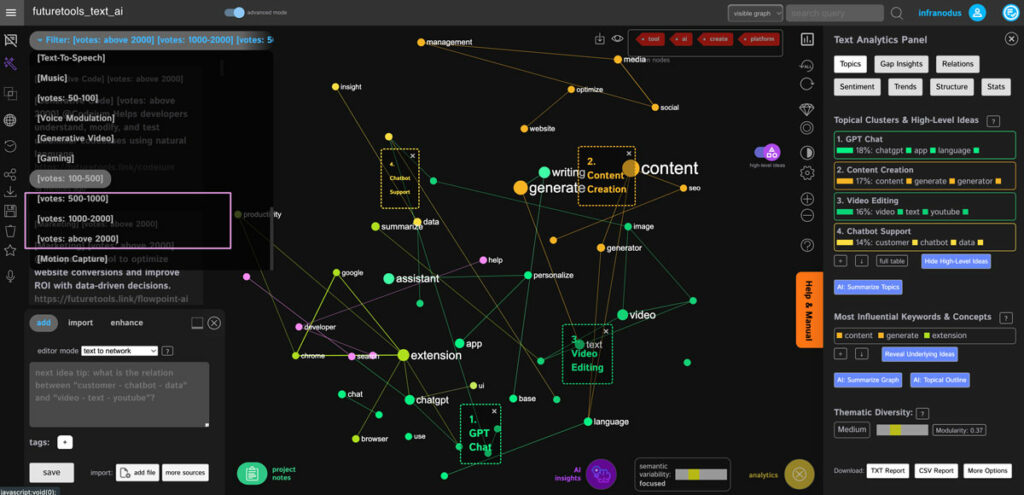
As we can see, their descriptions are similar to the overall picture, because they are focused on
• content creation and
• chatbots.
However, there is a tendency towards ChatGPT or GPT-like end-consumer tools (e.g. PDF file summarizers) rather than custom chatbot builders (that require more programming knowledge).
Mid-Popular AI Tools: Custom Chatbots, Writing Assistants, Summarization, and Google Extensions
Among the tools that have between 100 and 500 votes (about 10% of the tools), the most popular ones are described with the following topics:
• Chatbot Design
• Content Generation and Writing Assistants
• Video Summarization and Generation
• Google Chrome Extensions
These tools mainly focus on chatbot design.
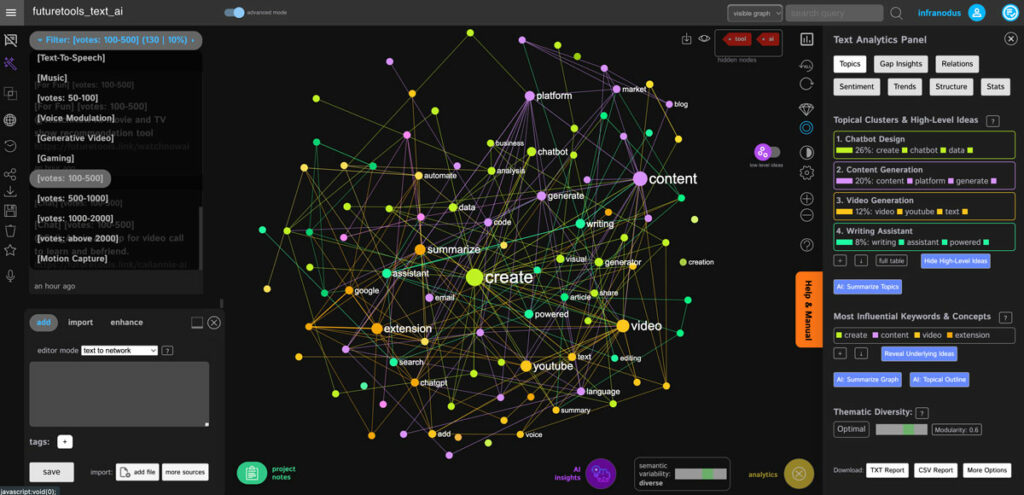
As you can see, the words “create”, “content”, “generate”, and “platform” are quite prominent in the graph. Those are quite obvious as most tool descriptions are focused on creating and generating content or being a platform. If we hide them from the graph we can see the context around them:
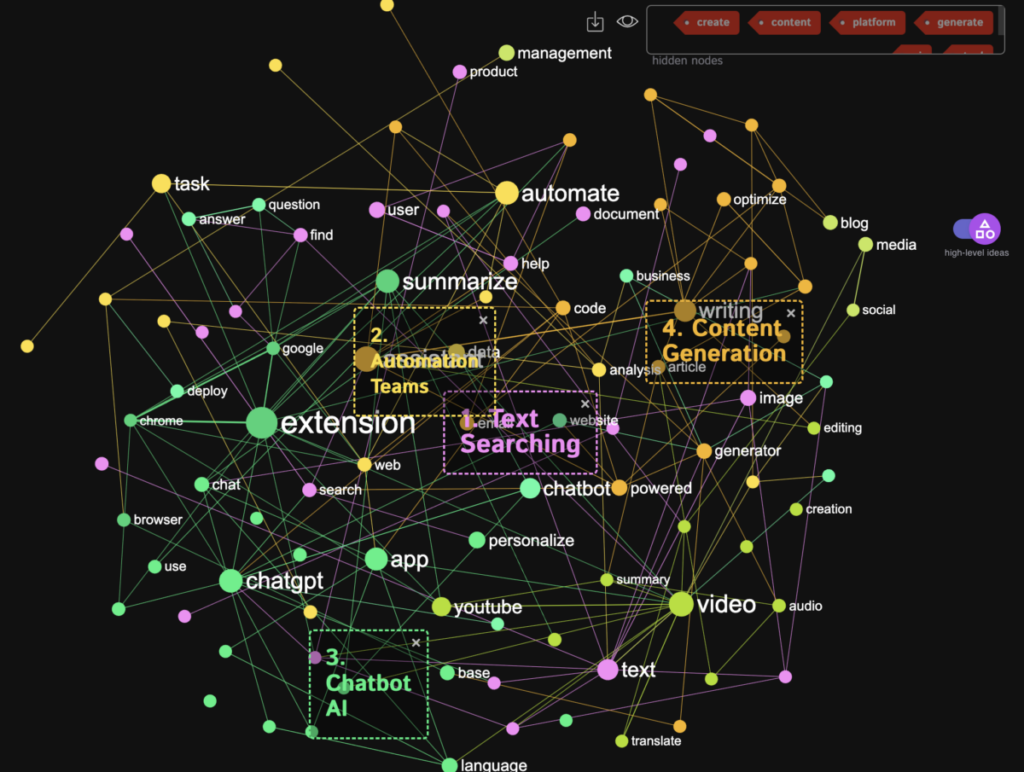
As we can see,
• chatgpt extension summarize
and
• youtube video
are the two clusters that come up behind those topics, which may indicate a potentially interesting niche to explore.
Least Popular Tools: B2B and Customer Support
There are 308 or about 23% of tools that have between 10 and 30 votes. These are mainly business applications, which explains their low number of votes as they are probably geared towards B2B customers:
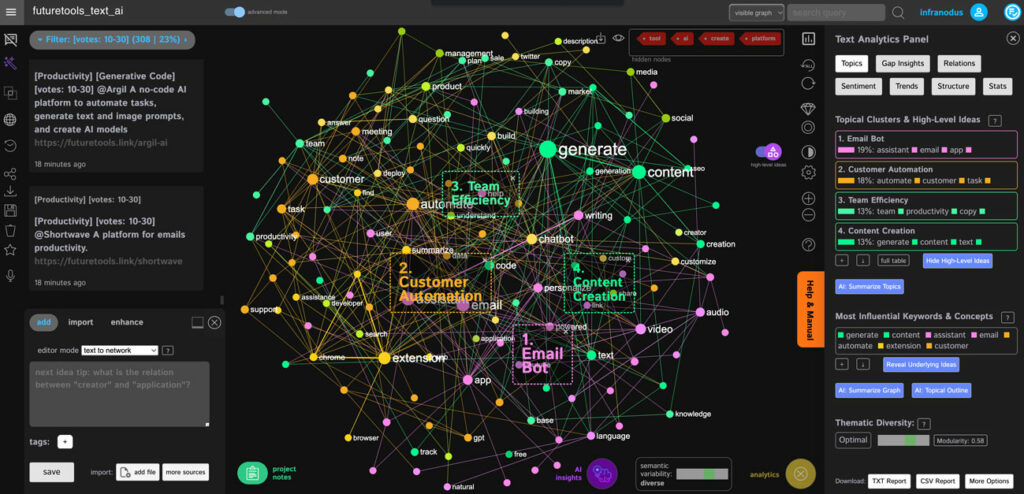
Those are email bots, customer support automation, and team productivity tools. Most likely, only some of these products will take off as many AI functionalities will simply be integrated into already existing project management / email / customer support tools.
There are also 36 (or 1%) of the least popular tools that got less than 10 votes, but their topics are dispersed so there are no meaningful patterns forming for those outliers.
Try It Out
If you’d like to explore the various AI tools featured on FutureTools.Io website using the keyword graph, check out the live InfraNodus graph here:

